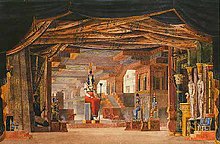Moïse et Pharaon
| Mosè in Egitto | |
|---|---|
| Opera by Gioachino Rossini | |

The composer in 1815
|
|
| Librettist | Andrea Leone Tottola |
| Language | Italian |
| Based on |
L'Osiride by Francesco Ringhieri |
| Premiere | 5 March 1818 Teatro San Carlo, Naples |
| Moïse et Pharaon | |
|---|---|

Scene for the third act in the 1827 production
|
|
| Librettist | |
| Language | French |
| Premiere | 26 March 1827 Salle Le Peletier, Paris |
Mosè in Egitto (Moses in Egypt) (pronounced [moˈzɛ in eˈdʒitto]) is a three-act opera written by Gioachino Rossini to an Italian libretto by Andrea Leone Tottola, which was based on a 1760 play by Francesco Ringhieri, L'Osiride. It premièred on 5 March 1818 at the recently reconstructed Teatro San Carlo in Naples, Italy.
In 1827 Rossini revised the work with a new title: Moïse et Pharaon, ou Le passage de la Mer Rouge (Moses and Pharaoh, or The Crossing of the Red Sea) (pronounced [mɔiːz e faʁaɔ̃ u lə pasaːʒ də la mɛːʁ ʁuːʒ]). It was set to a four-act libretto written in French by Luigi Balocchi and Victor-Joseph Étienne de Jouy and the première was given by the Paris Opera at the Salle Le Peletier on 26 March the same year.
Riccardo Muti and many scholars consider Moïse et Pharaon, along with Guillaume Tell, to be among Rossini's greatest achievements:
Mosè in Egitto, 1818
The opera was loosely based on the Exodus from Egypt of the Israelites, led by Moses, rendered agreeable to the opera stage by introducing a love theme, in which the Pharaoh's son Amenophis plans to prevent their departure, since he loves the Israelite Anaïs.
The 1818 opera opens as the plague of darkness is dispelled by Moses' prayer, and it ends with the spectacle of the parting of the Red Sea and the drowning of Pharaoh's host, which "elicited howls of derision" at the clumsy machinery of its staging at the premiere, though the opera surmounted its technical failings and was a hit. Billed in 1818 as an azione tragico-sacra, the sacred drama with some features of the oratorio circumvented proscriptions of secular dramatic performances during Lent.
...
Wikipedia
